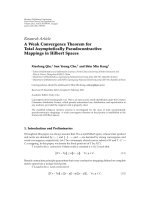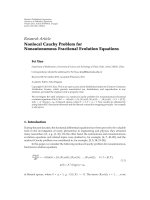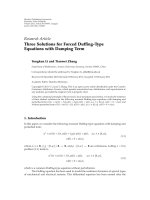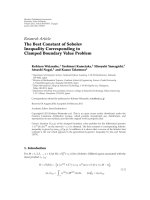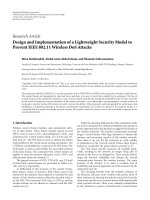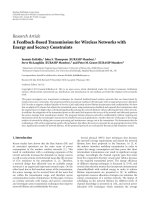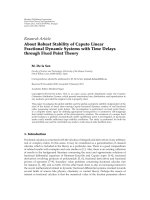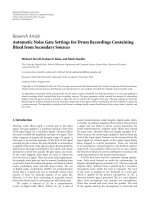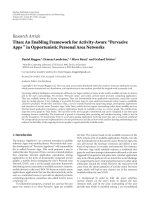báo cáo hóa học:" Research Article Minimal Nonnegative Solution of Nonlinear Impulsive Differential Equations on Infinite Interval" pot
Bạn đang xem bản rút gọn của tài liệu. Xem và tải ngay bản đầy đủ của tài liệu tại đây (521.51 KB, 15 trang )
Hindawi Publishing Corporation
Boundary Value Problems
Volume 2011, Article ID 684542, 15 pages
doi:10.1155/2011/684542
Research Article
Minimal Nonnegative Solution of
Nonlinear Impulsive Differential Equations on
Infinite Interval
Xuemei Zhang,
1
Xiaozhong Yang,
1
and Meiqiang Feng
2
1
Department of Mathematics and Physics, North China Electric Power University, Beijing 102206, China
2
School of Applied Science, Beijing Information Science and Technology University, Beijing 100192, China
Correspondence should be addressed to Xuemei Zhang,
Received 20 May 2010; Accepted 19 July 2010
Academic Editor: Gennaro Infante
Copyright q 2011 Xuemei Zhang et al. This is an open access article distributed under the Creative
Commons Attribution License, which permits unrestricted use, distribution, and reproduction in
any medium, provided the original work is properly cited.
The cone theory and monotone iterative technique are used to investigate the minimal nonnegative
solution of nonlocal boundary value problems for second-order nonlinear impulsive differential
equations on an infinite interval with an infinite number of impulsive times. All the existing
results obtained in previous papers on nonlocal boundary value problems are under the case of
the boundary conditions with no impulsive effects or the boundary conditions with impulsive
effects on a finite interval with a finite number of impulsive times, so our work is new. Meanwhile,
an example is worked out to demonstrate the main results.
1. Introduction
The theory of impulsive differential equations describes processes which experience a sudden
change of their state at certain moments. Processes with such a character arise naturally
and often, especially in phenomena studied in physics, chemical technology, population
dynamics, biotechnology, and economics. The theory of impulsive differential equations has
become an important area of investigation in the recent years and is much richer than the
corresponding theory of differential equations. For an introduction of the basic theory of
impulsive differential equations in R
n
; see Lakshmikantham et al. 1, Bainov and Simeonov
2, and Samo
˘
ılenko and Perestyuk 3 and the references therein.
Usually, we only consider the differential equation, integrodifferential equation,
functional differential equations, or dynamic equations on time scales on a finite interval
with a finite number of impulsive times. To identify a few, we refer the reader to 4–13
and references therein. In particular, we would like to mention some results of Guo and Liu
2 Boundary Value Problems
5 and Guo 6.In5, by using fixed-point index theory for cone mappings, Guo and Liu
investigated the existence of multiple positive solutions of a boundary value problem for the
following second-order impulsive differential equation:
−x
t
f
t, x
t
t ∈ J, t
/
t
k
,k 1, 2, ,m,
Δx
|
tt
k
I
k
x
t
k
,k 1, 2, ,m,
ax
0
− bx
0
θ, cx
1
dx
1
θ,
1.1
where f ∈ CJ × P, P,J0, 1,Pis a cone in the real Banach space E, θ denotes the zero
element of E, ft, θθ for t ∈ J, I
k
θθ, k 1, 2, ,m, 0 <t
1
<t
2
< ··· <t
k
< ··· <t
m
<
1,a≥ 0,b≥ 0,c≥ 0,d≥ 0andδ ac ad bc > 0.
In 6, by using fixed-point theory, Guo established the existence of solutions of a
boundary value problem for the following second-order impulsive differential equation in
a Banach space E :
−x
t
f
t, x, x
t
t ∈ J, t
/
t
k
,k 1, 2, ,m,
Δx
|
tt
k
I
k
x
t
k
,k 1, 2, ,m,
Δx
tt
k
N
k
x
t
k
,x
t
k
,k 1, 2, ,m,
ax
0
− bx
0
x
0
,cx
1
dx
1
x
∗
0
,
1.2
where f ∈ CJ × E × E, E,J0, 1, I
k
∈ CE, E,N
k
∈ CE × E, E,x
0
,x
∗
0
∈ E, 0 <t
1
<t
2
<
···<t
k
< ···<t
m
< 1, and p ac ad bc
/
0.
On the other hand, the readers can also find some recent developments and
applications of the case that impulse effects on a finite interval with a finite number
of impulsive times to a variety of problems from Nieto and Rodr
´
ıguez-L
´
opez 14–16 ,
Jankowski 17–19, Lin and Jiang 20,MaandSun21,HeandYu22, Feng and Xie 23,
Yan 24, Benchohra et al. 25, and Benchohra et al. 26.
Recently, in 27, Li and Nieto obtained some new results of the case that impulse
effects on an infinite interval with a finite number of impulsive times. By using a fixed-point
theorem due to Avery and Peterson 28, Li and Nieto considered the existence of multiple
positive solutions of the following impulsive boundary value problem on an infinite interval:
u
t
q
t
f
t, u
0, ∀0 <t<∞,t
/
t
k
,k 1, 2, ,p
Δu
t
k
I
k
u
t
k
,k 1, 2, ,p,
u
0
m−2
i1
α
i
u
ξ
i
,u
∞
0,
1.3
where f ∈ C0, ∞×0, ∞, 0, ∞,I
k
∈ C0, ∞, 0, ∞,u
∞lim
t → ∞
u
t, 0 <
ξ
1
<ξ
2
< ···<ξ
m−2
< ∞, 0 <t
1
<t
2
< ···<t
p
< ∞, and q ∈ C0, ∞, 0, ∞.
Boundary Value Problems 3
At the same time, we also notice that there has been increasing interest in studying
nonlinear differential equation and impulsive integrodifferential equation on an infinite
interval with an infinite number of impulsive times; to identify a few, we refer the reader to
Guo and Liu 29,Guo30–32, and Li and Shen 33. It is here worth mentioning the works
by Guo 31.In31, Guo investigated the minimal nonnegative solution of the following
initial value problem for a second order nonlinear impulsive integrodifferential equation of
Volterra type on an infinite interval with an infinite number of impulsive times in a Banach
space E:
x
f
t, x, Tx
, ∀t ≥ 0,t
/
t
k
,
Δx
|
tt
k
I
k
x
t
k
,
Δx
tt
k
N
k
x
t
k
k 1, 2,
,
x
0
x
0
,x
0
x
∗
0
,
1.4
where f ∈ CJ × P × P, E,I
k
,N
k
∈ CP, P,J0, ∞,x
0
,x
∗
0
∈ P, 0 <t
1
< ··· <t
k
< ··· <
··· ,t
k
→∞, as k →∞,Pis a cone of E.
However, the corresponding theory for nonlocal boundary value problems for
impulsive differential equations on an infinite interval with an infinite number of impulsive
times is not investigated till now. Now, in this paper, we will use the cone theory and
monotone iterative technique to investigate the existence of minimal nonnegative solution
for a class of second-order nonlinear impulsive differential equations on an infinite interval
with an infinite number of impulsive times.
Consider the following boundary value problem for second-order nonlinear impulsive
differential equation:
−x
t
f
t, x
t
,x
t
t ∈ J, t
/
t
k
,
Δx
|
tt
k
I
k
x
t
k
,k 1, 2, ,
Δx
tt
k
I
k
x
t
k
,k 1, 2, ,
x
0
∞
0
g
t
x
t
dt, x
∞
0,
1.5
where J 0, ∞,f ∈ CJ × R
× R
,R
,R
0, ∞, 0 <t
1
<t
2
< ··· <t
k
<
··· ,t
k
→∞,I
k
∈ CR
,R
, I
k
∈ CR
,R
,gt ∈ CR
,R
, with
∞
0
gtdt < 1.x
∞
lim
t →∞
x
t. Δx|
tt
k
denotes the jump of xt at t t
k
,thatis,
Δx
|
tt
k
x
t
k
− x
t
−
k
, 1.6
where xt
k
and xt
−
k
represent the right-hand limit and left-hand limit of xt at t t
k
,
respectively. Δx
|
tt
k
has a similar meaning for x
t.
4 Boundary Value Problems
Let
PC
J, R
x : x is a map from J into R such that x
t
is continuous at t
/
t
k
,
left continuous at t t
k
and x
t
k
exist for k 1, 2,
,
PC
1
J, R
x ∈ PC
J, R
: x
t
exists and is continuous at t
/
t
k
,
left continuous at t t
k
and x
t
k
exist for k 1, 2,
.
1.7
Let E {x ∈ PC
1
J, R :sup
t∈J
|xt|/1 t < ∞, sup
t∈J
|x
t| < ∞} with the norm
x max{x
1
, x
∞
}, where
x
1
sup
t∈J
|
x
t
|
1 t
,
x
∞
sup
t∈J
x
t
.
1.8
Define a cone P ⊂ E by
P
x ∈ E : x
t
≥ 0,x
t
≥ 0
. 1.9
Let J
J \{t
1
,t
2
, ,t
k
, ,},J
0
0,t
1
, and J
i
t
i
,t
i1
i 1, 2, 3, . x ∈ E ∩
C
2
J
,R is called a nonnegative solution of 1.5,ifxt ≥ 0,x
t ≥ 0andxt satisfies 1.5.
If I
k
0, I
k
0,k 1, 2, ,gt0, then boundary value problem 1.5 reduces to the
following two point boundary value problem:
−x
t
f
t, x
t
,x
t
t ∈ J,
x
0
0,x
∞
0,
1.10
which has been intensively studied; see Ma 34, Agarwal and O’Regan 35, Constantin 36,
Liu 37, 38, and Yan and Liu 39 for some references along this line.
The organization of this paper is as follows. In Section 2, we provide some necessary
background. In Section 3, the main result of problem 1.5 will be stated and proved. In
Section 4, we give an example to illustrate how the main results can be used in practice.
2. Preliminaries
To establish the existence of minimal nonnegative solution in E of problem 1.5, let us list
the following assumptions, which will stand throughout this paper.
Boundary Value Problems 5
H
1
Suppose that f ∈ CJ × R
× R
,R
,I
k
∈ CR
,R
, I
k
∈ CR
,R
, and there
exist p,q,r ∈ CJ, R
and nonnegative constants c
k
,d
k
,e
k
,f
k
such that
f
t, u, v
≤ p
t
u q
t
v r
t
, ∀t ∈ J, and ∀u, v ∈ R
,
I
k
u
≤ c
k
u d
k
, ∀u ∈ R
k 1, 2, 3
,
I
k
u
≤ e
k
u f
k
, ∀u ∈ R
k 1, 2, 3
,
p
∗
∞
0
p
t
t 1
dt < ∞,q
∗
∞
0
q
t
dt < ∞,
r
∗
∞
0
r
t
dt < ∞,c
∗
∞
k1
t
k
1
c
k
< ∞,
d
∗
∞
k1
d
k
< ∞,e
∗
∞
k1
t
k
1
e
k
< ∞,f
∗
∞
k1
f
k
< ∞.
2.1
H
2
ft, u
1
,v
1
≤ ft, u
2
,v
2
,I
k
u
1
≤ I
k
u
2
, I
k
u
1
≤ I
k
u
2
, for t ∈ J, u
1
≤ u
2
,v
1
≤
v
2
k 1, 2, 3 .
Lemma 2.1. Suppose that H
1
holds. Then for all x ∈ P,
∞
0
ft, xt,x
tdt,
∞
k1
I
k
xt
k
, and
∞
k1
I
k
xt
k
are convergent.
Proof. By H
1
, we have
f
t, x
t
,x
t
≤ p
t
t 1
x
t
t 1
q
t
x
t
r
t
,
I
k
x
t
k
≤ c
k
t
k
1
x
t
k
t
k
1
d
k
,
I
k
x
t
k
≤ e
k
t
k
1
x
t
k
t
k
1
f
k
.
2.2
Thus,
∞
0
f
s, x
s
,x
s
ds ≤ p
∗
||
x
||
1
q
∗
x
∞
r
∗
< ∞,
∞
k1
I
k
x
t
k
≤ c
∗
x
1
d
∗
< ∞,
∞
k1
I
k
x
t
k
≤ e
∗
x
1
f
∗
< ∞.
2.3
The proof is complete.
6 Boundary Value Problems
Lemma 2.2. Suppose that H
1
holds. If 0 ≤
∞
0
gtdt < 1,thenx ∈ E ∩ C
2
J
,R is a solution of
problem 1.5 if and only if x ∈ E is a solution of the following impulsive integral equation:
x
t
∞
0
G
t, s
f
s, x
s
,x
s
ds
∞
k1
G
t, t
k
I
k
x
t
k
∞
k1
G
s
t, t
k
I
k
x
t
k
1
1 −
∞
0
g
t
dt
∞
0
g
t
∞
0
G
t, s
f
s, x
s
,x
s
ds
∞
k1
G
t, t
k
I
k
x
t
k
∞
k1
G
s
t, t
k
I
k
x
t
k
dt, ∀t ∈ J,
2.4
where
G
t, s
⎧
⎨
⎩
t, 0 ≤ t ≤ s<∞,
s, 0 ≤ s ≤ t<∞,
G
s
t, s
⎧
⎨
⎩
0, 0 ≤ t ≤ s<∞,
1, 0 ≤ s ≤ t<∞.
2.5
Proof. First, suppose that x ∈ E ∩ C
2
J
,R is a solution of problem 1.5.Itiseasytoseeby
integration of 1.5 that
−x
t
x
0
t
0
f
s, x
s
,x
s
ds
t
k
<t
I
k
x
t
k
. 2.6
Taking limit for t →∞,byLemma 2.1 and the boundary conditions, we have
x
0
∞
0
f
s, x
s
,x
s
ds
∞
k1
I
k
x
t
k
. 2.7
Thus,
x
t
∞
0
f
s, x
s
,x
s
ds
∞
k1
I
k
x
t
k
−
t
0
f
s, x
s
,x
s
ds −
t
k
<t
I
k
x
t
k
. 2.8
Boundary Value Problems 7
Integrating 2.8, we can get
x
t
x
0
∞
0
G
t, s
f
s, x
s
,x
s
ds
∞
k1
G
t, t
k
I
k
x
t
k
∞
k1
G
s
t, t
k
I
k
x
t
k
∞
0
g
t
x
t
dt
∞
0
G
t, s
f
s, x
s
,x
s
ds
∞
k1
G
t, t
k
I
k
x
t
k
∞
k1
G
s
t, t
k
I
k
x
t
k
.
2.9
It follows that
∞
0
g
t
dt
1
1 −
∞
0
g
t
x
t
dt
∞
0
g
t
∞
0
G
t, s
f
s, x
s
,x
s
ds
∞
k1
G
t, t
k
I
k
x
t
k
∞
k1
G
s
t, t
k
I
k
x
t
k
dt.
2.10
So we have 2.4.
Conversely, suppose that x ∈ E is a solution of 2.4. Evidently,
Δx
|
tt
k
I
k
x
t
k
,
k 1, 2, ,
. 2.11
Direct differentiation of 2.4 implies, for t
/
t
k
,
x
t
∞
t
f
s, x
s
,x
s
ds
t
k
≥t
I
k
x
t
k
,
Δx
tt
k
I
k
x
t
k
,
k 1, 2, ,
,
x
t
−f
t, x
t
,x
t
.
2.12
So x ∈ C
2
J
,R.Itiseasytoverifythatx0
∞
0
gtxtdt, x
∞0. The proof of
Lemma 2.2 is complete.
Define an operator T : E → E,
Tx
t
∞
0
G
t, s
f
s, x
s
,x
s
ds
∞
k1
G
t, t
k
I
k
x
t
k
∞
k1
G
s
t, t
k
I
k
x
t
k
1
1 −
∞
0
g
t
dt
∞
0
g
t
∞
0
G
t, s
f
s, x
s
,x
s
ds
∞
k1
G
t, t
k
I
k
x
t
k
∞
k1
G
s
t, t
k
I
k
x
t
k
dt, ∀t ∈ J.
2.13
8 Boundary Value Problems
Lemma 2.3. Assume that H
1
and H
2
hold. Then operator T maps P into P, and
Tx
≤ β α
x
, ∀x ∈ P, 2.14
where
α
2 −
∞
0
g
t
dt
1 −
∞
0
g
t
dt
p
∗
q
∗
c
∗
e
∗
,β
2 −
∞
0
g
t
dt
1 −
∞
0
g
t
dt
r
∗
f
∗
d
∗
. 2.15
Moreover, for x,y ∈ P with xt ≤ yt,x
t ≤ y
t, for all t ∈ J
, one has
Tx
t
≤
Ty
t
,
Tx
t
≤
Ty
t
, ∀ t ∈ J
. 2.16
Proof. Let x ∈ P. From the definition of T and H
1
, we can obtain that T is an operator from
P into P,and
|
Tx
t
|
1 t
≤
∞
0
f
s, x
s
,x
s
ds
∞
k1
I
k
x
t
k
∞
k1
|
I
k
x
t
k
|
1
1 −
∞
0
g
t
dt
∞
0
f
s, x
s
,x
s
ds
∞
k1
I
k
x
t
k
∞
k1
|
I
k
x
t
k
|
≤
2 −
∞
0
g
t
dt
1 −
∞
0
g
t
dt
p
∗
q
∗
c
∗
e
∗
x
2 −
∞
0
g
t
dt
1 −
∞
0
g
t
dt
r
∗
f
∗
d
∗
α
x
β, ∀t ∈ J.
2.17
Direct differentiation of 2.13 implies, for t
/
t
k
,
Tx
t
∞
t
f
s, x
s
,x
s
ds
t
k
≥t
I
k
x
t
k
. 2.18
Thus we have |Tx
t|≤
∞
0
|fs, xs,x
s|ds
∞
k1
|I
k
xt
k
|≤αx β, for all t ∈ J
. It
follows that 2.14 is satisfied. Equation 2.16 is easily obtained by H
2
.
Boundary Value Problems 9
3. Main Result
In this section, we establish the existence of a minimal nonnegative solution for problem 1.5.
Theorem 3.1. Let conditions H
1
-H
2
be satisfied. Suppose further that
α
2 −
∞
0
g
t
dt
1 −
∞
0
g
t
dt
p
∗
q
∗
c
∗
e
∗
< 1. 3.1
Then problem 1.5 has the minimal nonnegative solution
x with x≤β/1 − α,whereβ is defined
as in Lemma 2.3. Here, the meaning of minimal nonnegative solution is that if x is an arbitrary
nonnegative solution of 1.5,thenxt ≥
xt,x
t ≥ x
t, for all t ∈ J
. Moreover, if we let
x
0
t0,x
n
tTx
n−1
t, for all t ∈ J n 1, 2, , then x
n
⊂ P with
0 x
0
t
≤ x
1
t
≤···≤ x
n
t
≤···≤
x
t
, ∀t ∈ J,
0 x
0
t
≤ x
1
t
≤···≤ x
n
t
≤···≤
x
t
, ∀t ∈ J
,
3.2
and {x
n
t} and {x
n
t} converge uniformly to xt and x
t on J
i
, i 0, 1, 2, , respectively.
Proof. By Lemma 2.3 and the definition of operator T, we have x
n
⊂ P,and
x
n
≤ β α
x
n−1
n 1, 2, 3,
, 3.3
0 x
0
t
≤ x
1
t
≤···≤ x
n
t
≤··· , ∀t ∈ J, 3.4
0 x
0
t
≤ x
1
t
≤···≤ x
n
t
≤··· , ∀t ∈ J
. 3.5
By 3.3, we have
x
n
≤ β αβ α
2
β ··· α
n−1
β
β
1 − α
n
1 − α
≤
β
1 − α
,
n 1, 2
. 3.6
From 3.4, 3.5,and3.6, we know that lim
n →∞
x
n
t and lim
n →∞
x
n
t exist. Suppose that
lim
n →∞
x
n
t
x
t
, lim
n →∞
x
n
t
y
t
, ∀t ∈ J
.
3.7
10 Boundary Value Problems
By the definition of x
n
t, we have
x
n
t
∞
t
f
s, x
n−1
s
,x
n−1
s
ds
t
k
≥t
I
k
x
n
t
k
, ∀t ∈ J
,
n 1, 2,
,
3.8
x
n
t
−f
t, x
n−1
t
,x
n−1
t
, ∀t ∈ J
,
n 1, 2,
. 3.9
From 3.6,weobtain
|
x
n
t
|
t 1
≤
β
1 − α
,
x
n
t
≤
β
1 − α
, ∀t ∈ J
,
n 1, 2,
.
3.10
It follows that {x
n
t} is equicontinuous on every J
i
i 0, 1, 2, . Combining this with
Ascoli-Arzela theorem and diagonal process, there exists a subsequence which converges
uniformly to
xt on J
i
i 0, 1, 2, . Which together with 3.4 imply that {x
n
t} converges
uniformly to
xt on J
i
i 0, 1, 2, ,andx ∈ PCJ, R, x
1
≤ β/1−α. On the other hand,
by H
1
,3.6,and3.9, we have
x
n
t
≤ p
t
t 1
x
n−1
1
q
t
x
n−1
∞
r
t
≤ p
t
t 1
β
1 − α
q
t
β
1 − α
r
t
s
t
∈ C
J, R
, ∀t ∈ J
n 1, 2,
.
3.11
Since st is bounded on 0,MM is a finite positive number, {x
n
t} is equicontinuous
on every J
i
,i 1, 2, Combining this with Ascoli-Arzela theorem and diagonal process,
there exists a subsequence which converges uniformly to yt on J
i
i 0, 1, 2, , which
together with 3.5 imply that {x
n
t} converges uniformly to yt on J
i
i 0, 1, 2, ,
and y ∈ PCJ, R, y
∞
≤ β/1 − α. From above, we know that x
t exists and x
t
yt, for all t ∈ J
. It follows that x ∈ P and
x
≤
β
1 − α
.
3.12
Now we prove that
xtTxt.
By the continuity of f and the uniform convergence of x
n
t,x
n
t, we know that
f
s, x
n
s
,x
n
s
−→ f
s,
x
s
, x
s
,n−→ ∞ , ∀t ∈ J
. 3.13
On the other hand, by H
1
and 3.6 and 3.12, we have
f
s, x
n
s
,x
n
s
− f
s,
x
s
, x
s
≤ 2
p
s
s 1
q
s
β
1 − α
2r
s
z
s
∈ L
J, R
n 1, 2,
.
3.14
Boundary Value Problems 11
Combining this with the dominated convergence theorem, we have
lim
n →∞
∞
t
f
s, x
n
s
,x
n
s
ds
∞
t
f
s, x
s
, x
s
ds, ∀t ∈ J,
lim
n →∞
t
0
f
s, x
n
s
,x
n
s
ds
t
0
f
s, x
s
, x
s
ds, ∀t ∈ J.
3.15
Moreover, we can see that
lim
n →∞
0<t
k
<t
I
k
x
n
t
k
0<t
k
<t
I
k
x
t
k
,
lim
n →∞
0<t
k
<t
I
k
x
n
t
k
0<t
k
<t
I
k
x
t
k
,
lim
n →∞
t
k
≥t
I
k
x
n
t
k
t
k
≥t
I
k
x
t
k
,
lim
n →∞
t
k
≥t
I
k
x
n
t
k
t
k
≥t
I
k
x
t
k
.
3.16
Now taking limits from two sides of x
n
tTx
n−1
t and using 3.15–3.16, we have
x
t
∞
0
G
t, s
f
s, x
s
, x
s
ds
∞
k1
G
t, t
k
I
k
x
t
k
∞
k1
G
s
t, t
k
I
k
x
t
k
1
1 −
∞
0
g
t
dt
∞
0
g
t
∞
0
G
t, s
f
s, x
s
, x
s
ds
∞
k1
G
t, t
k
I
k
x
t
k
∞
k1
G
s
t, t
k
I
k
x
t
k
dt, ∀t ∈ J.
3.17
By Lemma 2.2,
xt is a nonnegative solution of 1.5.
Suppose that x ∈ P ∩ C
2
J
,R is an arbitrary nonnegative solution of 1.5. Then
xtTxt. It is clear that xt ≥ 0,x
t ≥ 0, ∀t ∈ J
. Suppose that xt ≥ x
n−1
t,x
t ≥
x
n−1
t, for all t ∈ J
. By 2.16 we have Txt ≥ Tx
n−1
t, Tx
t ≥ Tx
n−1
t, for all t ∈
J
. This means that xt ≥ x
n
t,x
t ≥ x
n
t, for all t ∈ J
n 1, 2, . Taking limit, we
have xt ≥
xt,x
t ≥ x
t, for all t ∈ J
. The proof of Theorem 3.1 is complete.
12 Boundary Value Problems
4. Example
To illustrate how our main results can be used in practice, we present an example.
Example 4.1. Consider the following boundary value problem of second-order impulsive
differential equation on infinite interval
−x
1
100
t 1
−9/4
1 x x
2/3
,t∈ J, t
/
k,
Δx
|
tk
1
8
k
x
k
1
1/2
k 1, 2,
,
Δx
|
tk
1
10
k
x
k
1
1/2
k 1, 2,
,
x
0
∞
0
1
2
e
−t
x
t
dt, x
∞
0,
4.1
where
f
t, x, y
1
100
t 1
−9/4
1 x y
2/3
,
I
k
x
t
k
1
8
k
x
k
1
1/2
,k 1, 2, ,
I
k
x
t
k
1
10
k
x
k
1
1/2
,k 1, 2, ,
g
t
1
2
e
−t
.
4.2
Evidently, xt ≡ 0 is not the solution of 4.1.
Conclusion
Problem 4.1 has minimal positive solution.
Proof. It is clear that
∞
0
1/2e
−t
dt < 1andH
2
is satisfied.
By the inequality 1 x
γ
≤ 1 γx,for all 0 ≤ x<∞, 0 <γ<1, we see that
f
t, x, y
≤
1
100
t 1
−9/4
1
2
3
x
2
3
y
,
I
k
x
≤
1
8
k
1
1
2
x
,
I
k
x
≤
1
10
k
1
1
2
x
,k 1, 2,
4.3
Boundary Value Problems 13
Let
p
t
1
150
t 1
−9/4
,q
t
1
150
t 1
−9/4
,r
t
1
100
t 1
−9/4
,
c
k
1
2 × 8
k
,d
k
1
8
k
,e
k
1
2 × 10
k
,f
k
1
10
k
.
4.4
Then, we easily obtain that
∞
0
p
t
1 t
dt
4
150
,
∞
0
q
t
dt
4
750
,
∞
0
r
t
dt
2
250
,
∞
k1
t
k
1
c
k
15
98
,
∞
k1
d
k
1
7
,
∞
k1
t
k
1
e
k
19
162
,
∞
k1
f
k
1
9
.
4.5
Thus, H
1
is satisfied and α 150001/165375 < 1. By Theorem 3.1, it f ollows that problem
4.1 has a minimal positive solution.
Acknowledgments
This work is supported by the National Natural Science Foundation of China 10771065,
the Natural Sciences Foundation of Hebei Province A2007001027, the Funding Project
for Academic Human Resources Development in Institutions of Higher Learning Under
the Jurisdiction of Beijing Municipality PHR201008430, the Scientific Research Common
Program of Beijing Municipal Commission of EducationKM201010772018, the 2010 level
of scientific research of improving project 5028123900, and Beijing Municipal Education
Commission71D0911003. The authors thank the referee for his/her careful reading of the
paper and useful suggestions.
References
1 V. Lakshmikantham, D. D. Ba
˘
ınov,andP.S.Simeonov,Theory of Impulsive Differential Equations, vol. 6
of Series in Modern Applied Mathematics, World Scientific, Teaneck, NJ, USA, 1989.
2 D. D. Ba
˘
ınov and P. S. Simeonov, Systems with Impulse E ffect: Stability, Theory and Application, Ellis
Horwood Series: Mathematics and Its Applications, Ellis Horwood, Chichester, UK, 1989.
3 A. M. Samo
˘
ılenko and N. A. Perestyuk, Impulsive Differential Equations, vol. 14 of World Scientific Series
on Nonlinear Science. Series A: Monographs and Treatises, World Scientific, River Edge, NJ, USA, 1995.
4 D. Guo, “Multiple positive solutions of impulsive nonlinear Fredholm integral equations and
applications,” Journal of Mathematical Analysis and Applications, vol. 173, no. 1, pp. 318–324, 1993.
5 D. Guo and X. Liu, “Multiple positive solutions of boundary-value problems for impulsive
differential equations,” Nonlinear Analysis: Theory, Methods & Applications, vol. 25, no. 4, pp. 327–337,
1995.
6 D. Guo, “Existence of solutions of boundary value problems for nonlinear second order impulsive
differential equations in Banach spaces,” Journal of Mathematical Analysis and Applications, vol. 181, no.
2, pp. 407–421, 1994.
7 D. Guo, “Periodic boundary value problems for second order impulsive integro-differential equations
in Banach spaces,” Nonlinear Analysis: Theory, Methods & Applications, vol. 28, no. 6, pp. 983–997, 1997.
8 X. Liu, “Monotone iterative technique for impulsive differential equations in a Banach space,” Journal
of Mathematical and Physical Sciences, vol. 24, no. 3, pp. 183–191, 1990.
14 Boundary Value Problems
9 A. S. Vatsala and Y. Sun, “Periodic boundary value problems of impulsive differential equations,”
Applicable Analysis, vol. 44, no. 3-4, pp. 145–158, 1992.
10 J. J. Nieto, “Basic theory for nonresonance impulsive periodic problems of first order,” Journal of
Mathematical Analysis and Applications, vol. 205, no. 2, pp. 423–433, 1997.
11 Z. He and W. Ge, “Periodic boundary value problem for first order impulsive delay differential
equations,” Applied Mathematics and Computation, vol. 104, no. 1, pp. 51–63, 1999.
12 M. Benchohra, J. Henderson, S. K. Ntouyas, and A. Ouahab, “Impulsive functional differential
equations with variable times,” Computers & Mathematics with Applications, vol. 47, no. 10-11, pp. 1659–
1665, 2004.
13 M. Benchohra, S. K. Ntouyas, and A. Ouahab, “Existence results for second order boundary value
problem of impulsive dynamic equations on time scales,” Journal of Mathematical Analysis and
Applications, vol. 296, no. 1, pp. 65–73, 2004.
14 J. J. Nieto and R. Rodr
´
ıguez-L´opez, “New comparison results for impulsive integro-differential
equations and applications,” Journal of Mathematical Analysis and Applications, vol. 328, no. 2, pp. 1343–
1368, 2007.
15 J. J. Nieto and R. Rodr
´
ıguez-L´opez, “Monotone method for first-order functional differential
equations,” Computers & Mathematics with Applications, vol. 52, no. 3-4, pp. 471–484, 2006.
16 J. J. Nieto and R. Rodr
´
ıguez-L´opez, “Periodic boundary value problem for non-Lipschitzian impulsive
functional differential equations,” Journal of Mathematical Analysis and Applications, vol. 318, no. 2, pp.
593–610, 2006.
17 T. Jankowski, “Positive solutions of three-point boundary value problems for second order impulsive
differential equations with advanced arguments,” Applied Mathematics and Computation, vol. 197, no.
1, pp. 179–189, 2008.
18 T. Jankowski, “Positive s olutions to second order four-point boundary value problems for impulsive
di
fferential equations,” Applied Mathematics and Computation, vol. 202, no. 2, pp. 550–561, 2008.
19 T. Jankowski, “Existence of solutions for second order impulsive differential equations with deviating
arguments,” Nonlinear Analysis: Theory, Methods & Applications, vol. 67, no. 6, pp. 1764–1774, 2007.
20 X. Lin and D. Jiang, “Multiple positive solutions of Dirichlet boundary value problems for second
order impulsive differential equations,” Journal of Mathematical Analysis and Applications, vol. 321, no.
2, pp. 501–514, 2006.
21 Y. Ma and J. Sun, “Stability criteria for impulsive systems on time scales,” Journal of Computational and
Applied Mathematics, vol. 213, no. 2, pp. 400–407, 2008.
22 Z. He and J. Yu, “Periodic boundary value problem for first-order impulsive functional differential
equations,” Journal of Computational and Applied Mathematics, vol. 138, no. 2, pp. 205–217, 2002.
23 M. Feng and D. Xie, “Multiple positive solutions of multi-point boundary value problem for second-
order impulsive differential equations,” Journal of Computational and Applied Mathematics, vol. 223, no.
1, pp. 438–448, 2009.
24 J. Yan, “Existence of positive periodic solutions of impulsive functional differential equations with
two parameters,” Journal of Mathematical Analysis and Applications, vol. 327, no. 2, pp. 854–868, 2007.
25 M. Benchohra, S. K. Ntouyas, and A. Ouahab, “Extremal solutions of second order impulsive dynamic
equations on time scales,” Journal of Mathematical Analysis and Applications, vol. 324, no. 1, pp. 425–434,
2006.
26 M. Benchohra, J. Henderson, and S. K. Ntouyas, Impulsive Differential Equations and Inclusions,
Hindawi, New York, NY, USA, 2006.
27 J. Li and J. J. Nieto, “Existence of positive solutions for multipoint boundary value problem on the
half-line with impulses,” Boundary Value Problems, vol. 2009, Article ID 834158, 12 pages, 2009.
28 R. I. Avery and A. C. Peterson, “Three positive fixed points of nonlinear operators on ordered Banach
spaces,” Computers & Mathematics with Applications, vol. 42, no. 3–5, pp. 313–322, 2001.
29 D. Guo and X. Z. Liu, “Impulsive integro-differential equations on unbounded domain in a Banach
space,” Nonlinear Studies, vol. 3, no. 1, pp. 49–57, 1996.
30
D. Guo, “Boundary value problems for impulsive integro-differential equations on unbounded
domains in a Banach space,” Applied Mathematics and Computation, vol. 99, no. 1, pp. 1–15, 1999.
31 D. Guo, “Second order impulsive integro-differential equations on unbounded domains in Banach
spaces,” Nonlinear Analysis: Theory, Methods & Applications, vol. 35, no. 4, pp. 413–423, 1999.
32 D. Guo, “Multiple positive solutions for first order nonlinear impulsive integro-differential equations
in a Banach space,” Applied Mathematics and Computation, vol. 143, no. 2-3, pp. 233–249, 2003.
33 J. Li and J. Shen, “Existence of positive solution for second-order impulsive boundary value problems
on infinity intervals,” Boundary Value Problems, vol. 2006, Article ID 14594, 11 pages, 2006.
Boundary Value Problems 15
34 R. Ma, “Existence of positive solutions for second-order boundary value problems on infinity
intervals,” Applied Mathematics Letters, vol. 16, no. 1, pp. 33–39, 2003.
35 R. P. Agarwal and D. O’Regan, “Boundary value problems of nonsingular type on the semi-infinite
interval,” The Tohoku Mathematical Journal, vol. 51, no. 3, pp. 391–397, 1999.
36 A. Constantin, “On an infinite interval boundary value problem,” Annali di Matematica Pura ed
Applicata. Serie Quarta, vol. 176, pp. 379–394, 1999.
37 Y. Liu, “Existence and unboundedness of positive solutions for singular boundary value problems on
half-line,” Applied Mathematics and Computation, vol. 144, no. 2-3, pp. 543–556, 2003.
38 Y. Liu, “Boundary value problems for second order differential equations on unbounded domains in
a Banach space,” Applied Mathematics and Computation, vol. 135, no. 2-3, pp. 569–583, 2003.
39 B. Yan and Y. Liu, “Unbounded solutions of the singular boundary value problems for second order
differential equations on the half-line,” Applied Mathematics and Computation, vol. 147, no. 3, pp. 629–
644, 2004.
